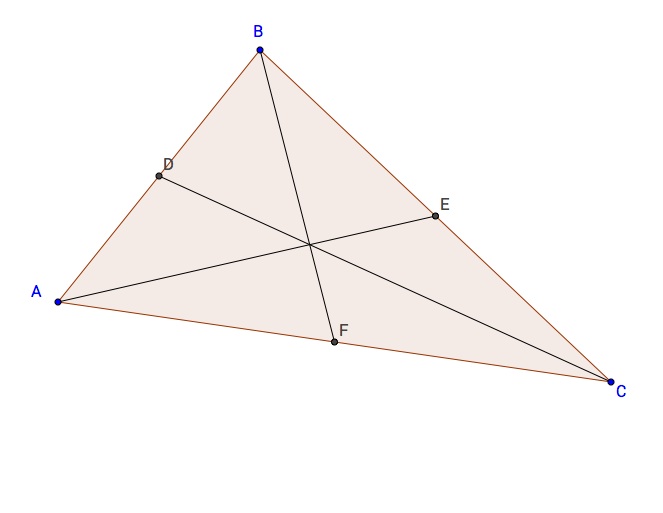
The Vector Average
By: John Vereen

How can we prove that the
intersection of the medians of this triangle, also known as the centroid, is
concurrent and is (2/3) the distance from a vertex to the midpoint of the
opposite side? Well first of all, letŐs consider how we should label each
point. In order to prove these two facts, I will consider each point A-F a
vector. We know that points A,B, and C can be thought
of as the vectors A,B, and C, but is there any way we can think of D, E, and F
in terms of vectors A,B, and C?
In order to prove the statement
above, we must think of vectors D,E, and F in terms of
vectors A, B, and C. By vector addition properties, we will think of point D as
the distance (1/2)(B+A). Because of this fact, we can think of the midpoint D
in vector form as (1/2)(B+A)-C. Using similar thinking, we will think of each midpoint
D, E, and F as:
D
= (1/2)(B+A) – C
E
= (1/2)(B+C) – A
F
= (1/2)(C+A) – B
Now, letŐs assume that the
intersection point of the medians above is actually 2/3 of the way from each
vertex to the midpoint of the opposite side. Then, we could represent this
relationship mathematically as follows:
C + (2/3) [(1/2)(B+A) – C]
= C + (1/3)B + (1/3)A
–(2/3)C
= (1/3)A +
(1/3)B + (1/3)C = (1/3)(A+B+C)
B + (2/3) [(1/2)(C+A) – B]
= B + (1/3)C
+ (1/3)A –(2/3)B
= (1/3)A +
(1/3)B + (1/3)C = (1/3)(A+B+C)
A + (2/3) [(1/2)(B+C) – A]
= A + (1/3)B
+ (1/3)C –(2/3)A
= (1/3)A +
(1/3)B + (1/3)C = (1/3)(A+B+C)
Thus, we can see that the point on each vector that is 2/3 of
the way from the vertex to the midpoint of the opposite side is (1/3)(A+B+C).
This proves that the medians of a triangle are concurrent and that their point
of intersection is (1/3)(A+B+C), which is the centroid.